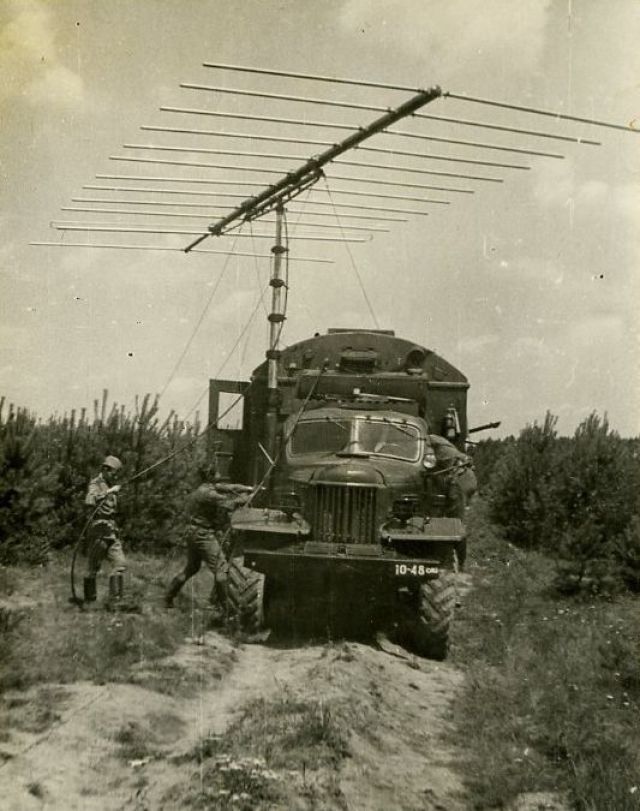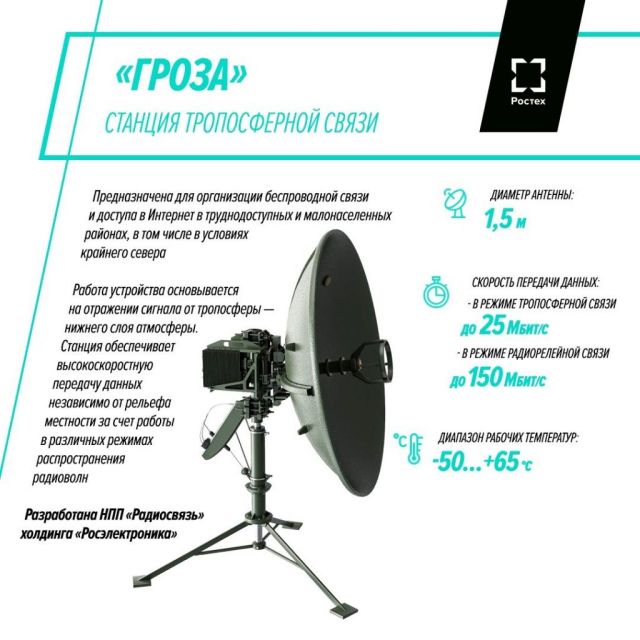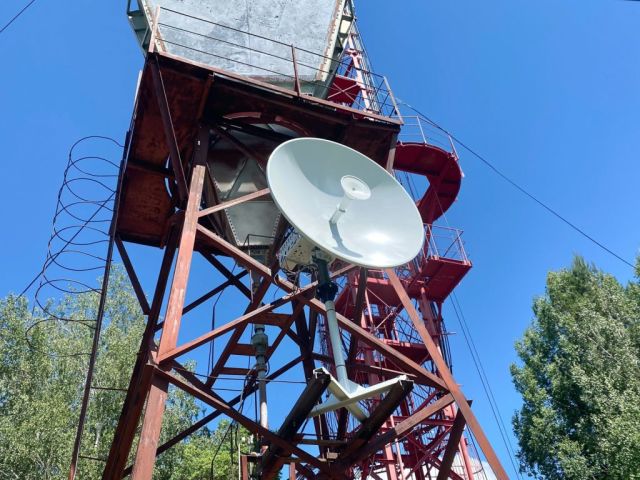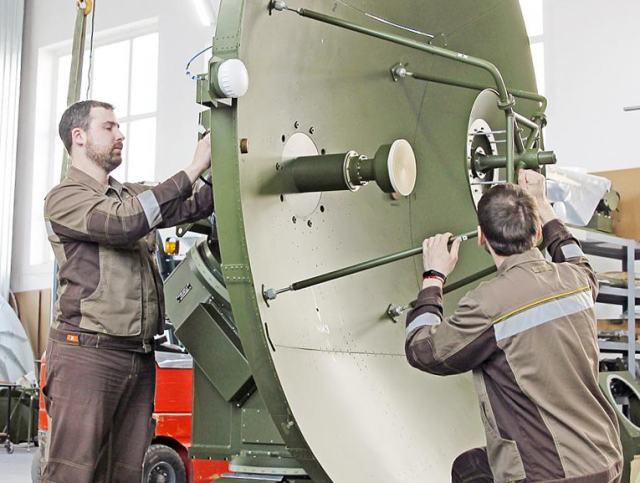High-speed tropospheric communication can become an alternative to satellite communication. In our country, this technology is being actively developed by Roselectronics. The holding has developed and is preparing for serial production of digital tropospheric communication stations "Groza".
We tell you how the tropospheric communication, previously used by the military, will help residents of the most remote corners of the country to always stay in the "access zone".
How the signal was sent over the horizon
Connecting two points very far from each other by radio was once considered an impossible task, for quite natural reasons - our planet is a ball, and even with a complex terrain. But already in the 40s of the last century, scientists managed to study and justify the possibility of over-the-horizon propagation of a radio signal.
The idea was actually simple – the signal should be directed not towards the receiver, but at an angle to the sky. At an altitude of about 10-15 km, radio waves are reflected from the upper boundary of the troposphere and sent to the receiver. Thus, the receiver and transmitter can be located at a distance of up to 600 km. In practice, this solution, of course, faces some difficulties. For example, depending on the geographical latitude, the height of such a "tropospheric mirror" is constantly changing, and the signal is greatly weakened during re-emission, which requires powerful transmitters and large antennas. But these difficulties were solved.
Like all the most advanced novelties, tropospheric communication emerged as a technology for the military. In the 1950s, Americans were excited about the increasing range of Soviet bombers, which could already "reach" the United States through the North Pole. In 1954, the construction of the DEW line, a network of early warning radar stations about a possible approach of enemy aircraft, began. Radars and the command center connected tropospheric radio relay lines.

In the 1960s, the domestic tropospheric station TR-60/120 was built, on the basis of which a network of tropospheric lines with a length of more than 15 thousand km appeared. This station was part of a grandiose project of that time – a communication line that connected Moscow and Delhi. The average section with a length of almost 700 km, between the cities of Dushanbe and Srinagar, is a tropospheric communication line. Thanks to the new technology, the most difficult segment was overcome – the Gikdukusha mountain ranges. This was the first experience in the world practice of building an international multichannel line of such length in high-altitude conditions.
Another striking example of success is the creation of the tropospheric communication line "North", the construction of which began in 1966 in conditions of permafrost and impassable taiga. The longest section – along the Yenisei River to Norilsk – connected most of the settlements of the region with Krasnoyarsk. The collapse of the USSR and the advent of satellite communications led to the closure of the stations – the latter stopped working in the early 2000s.
Tropospheric communication as an alternative to satellites
The development of satellite communications and fiber-optic communications has thoroughly displaced tropospheric communications and, at first glance, left it no chance. However, today there are more and more ideas about the return of this technology, as well as its potential not only in military affairs, but also in the "citizen".
Modern tropospheric communication stations are built on the basis of new digital solutions, therefore they are able to provide high data transfer rates. In addition, unlike the old models, today's models have reduced power consumption and radiated power. Thus, more and more experts agree that the use of tropospheric communication technology can significantly facilitate the creation of a standard telecommunications infrastructure in remote regions of our country. Recall that according to the national project "Digital Economy of the Russian Federation", 97% of Russians should have access to broadband Internet access by 2030.
When it comes to communications in hard-to-reach areas, tropospheric communication turns out to be a more profitable option compared to satellite or fiber-optic. The tropospheric communication station itself may be more expensive than a satellite communication terminal, but in the future it turns out to be a more profitable option, because you do not need to spend money for using a satellite.
Now the holding company "Roselectronics" of the Rostec State Corporation is already deploying the first pilot zones based on such equipment. For example, a high-speed tropospheric communication line was recently organized between Gorno-Altaisk and the Seminsky Pass, popular among travelers, located at an altitude of 1717 meters.

The troposphere station "Groza" developed by NPP "Radiosvyaz" is used in the pilot projects of the holding. The company is one of the leaders in the country in the creation of satellite and tropospheric ground stations. Today, Radiosvyaz specialists are introducing new methods of digital signal processing and upgrading equipment.
According to experts, for high reliability, communication lines should always be reserved by alternative technologies. Thus, even the highest quality fiber optic cable is subject to both man-made and natural influences. Satellite communication channels also need a "safety net".
Waiting for the "Thunderstorm"
Currently, high-speed tropospheric stations for civil purposes are not mass produced in Russia. Groza will be the first such serial station – its production is planned to be organized soon at the facilities of the Radiosvyaz enterprise.
The Thunderstorm kit includes an antenna with a diameter of 150 cm, which can be installed both on the roof of the building and on a tripod, as well as a high-speed digital modem for tropospheric communication. This modem was developed by the Radiosvyaz team, it uses the latest information processing approaches, including an equalizer based on neural networks.

The main difference between the new station and its predecessors is high speed. Modern radio relay and tropospheric stations, such as Groza, can be used for cellular communication and provide Internet speeds of up to 50 Mbit/s in tropospheric communication mode and up to 155 Mbit/s in radio relay communication mode.
The Thunderstorm has already proved its declared ability to work in extreme climatic conditions in practice, during pilot launches in the Altai Territory. In fact, the possibilities of the "Thunderstorm" are even wider – it is able to "work" at air temperatures from -50 to +65 degrees Celsius and humidity up to 98%. Strong winds with a speed of up to 20 m/s will not stop the "Thunderstorm".

